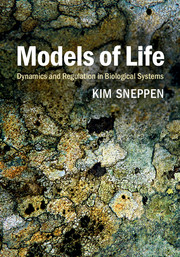Book contents
- Frontmatter
- Contents
- Preface
- 1 Life from a physics perspective
- 2 E. coli as a model system
- 3 Dynamics of regulatory links
- 4 Statistical mechanics of phage λ
- 5 Diffusion and randomness in transcription
- 6 Stochastic genes and persistent decisions
- 7 cis-Acting gene regulation and epigenetics
- 8 Feedback circuits
- 9 Networks
- 10 Signaling and metabolic networks
- 11 Agent-based models of signaling and selection
- 12 Competition and diversity
- 13 Evolution and extinction
- Appendix
- References
- Index
3 - Dynamics of regulatory links
Published online by Cambridge University Press: 05 October 2014
- Frontmatter
- Contents
- Preface
- 1 Life from a physics perspective
- 2 E. coli as a model system
- 3 Dynamics of regulatory links
- 4 Statistical mechanics of phage λ
- 5 Diffusion and randomness in transcription
- 6 Stochastic genes and persistent decisions
- 7 cis-Acting gene regulation and epigenetics
- 8 Feedback circuits
- 9 Networks
- 10 Signaling and metabolic networks
- 11 Agent-based models of signaling and selection
- 12 Competition and diversity
- 13 Evolution and extinction
- Appendix
- References
- Index
Summary
Regulating a piece of DNA
The information content of the genome is primarily managed by regulatory proteins through their interactions with the DNA, with each other, with RNA or with various small metabolic molecules. Some proteins, called transcription factors, regulate the production of other proteins by binding upstream of the genes for these proteins, thereby continually adjusting the metabolism and response of the cell to optimize future growth and survival.
Figure 3.1 shows two ways that a transcription factor (TF) can regulate the transcription of a gene. The right-hand panel shows a specific example of a regulatory protein that is bound to the DNA. The CAP (or CRP) protein is in fact the TF that regulates most genes in E. coli, and as such is the largest hub in its genetic regulatory network.
This chapter introduces a few quantitative models for genetic regulation. The basic process here is the binding–unbinding events of proteins, both to each other and to the operator DNA that controls transcription initiation. Thus, for readers that are not familiar with chemistry, we will now go through basic chemistry and co-operativity. In this section we follow the standard approach quite closely with on- and off-rates, and the consequences of co-operativity. In the next chapter we will venture into a more detailed discussion of how to treat binding as a combination of operators, and through this we will demonstrate how statistical mechanics provide us with a generic framework.
Information
- Type
- Chapter
- Information
- Models of LifeDynamics and Regulation in Biological Systems, pp. 36 - 48Publisher: Cambridge University PressPrint publication year: 2014
